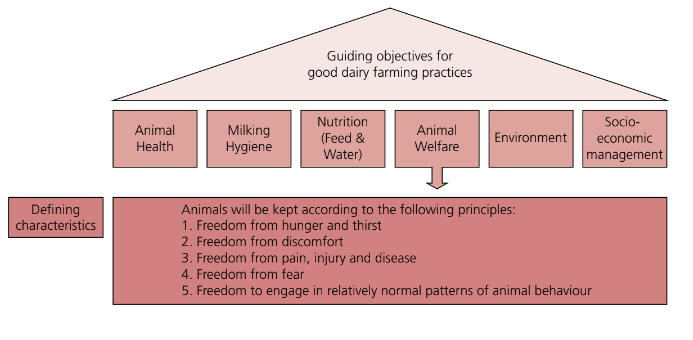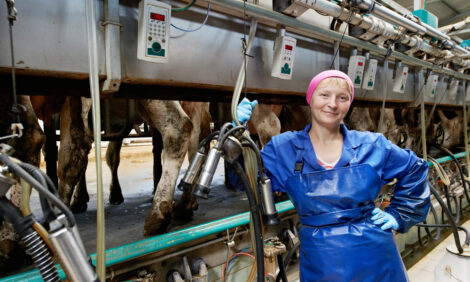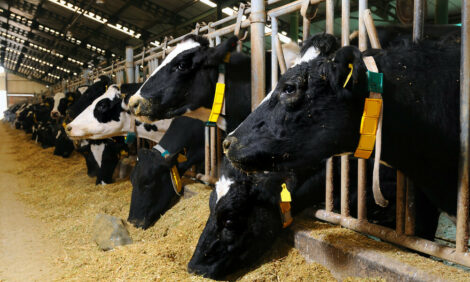



Guide to good dairy farming practice: Animal welfare
Learn more about dairy welfare best practicesPart of Series:
< Previous Article in Series Next Article in Series >
This article is from the Guide to Good Dairy Farming Practices, originally written and published by the Food and Agriculture Organization of the United Nations (FAO) and the International Dairy Federation. The Guide has been written in a practical format for dairy farmers engaged in the production of milk from any dairy species. When adopted, it will support the production and marketing of safe, quality-assured milk and dairy products. Additional sections of the Guide will be published as an article series.
In essence, animal welfare is the application of sensible and sensitive animal husbandry practices to the livestock on the farm. Animal welfare is primarily concerned with the well-being of the animal. In general, consumers perceive high animal welfare standards as an indicator that food is safe, healthy and of high quality. Animal welfare standards have been incorporated into most on-farm food quality and food safety schemes.
Many animal welfare codes list ‘five freedoms’14 that should underpin best farm practice in relation to animal welfare. These five freedoms provide a comprehensive overall concept of animal welfare.
The following information describes good dairy farming practices for animal welfare. They are set out to reflect the five freedoms:
- Ensure animals are free from thirst, hunger and malnutrition.
- Ensure animals are free from discomfort.
- Ensure animals are free from pain, injury and disease.
- Ensure animals are free from fear.
- Ensure animals can engage in relatively normal patterns of animal behaviour.

Ensure animals are free from thirst, hunger and malnutrition
Provide sufficient feed and water for all animals every day
Dairy livestock should be given sufficient feed, based on their physiological needs. Their requirements will vary according to their age, body weight, stage of lactation, production level, growth, pregnancy, activity and environment. Provide enough space around feeding and watering points to reduce bullying and ensure all livestock have sufficient access.
The quality (palatability and nutrient content) of the feed also needs to be considered, based on the animal’s dietary requirements. Dietary supplements need to be considered if the ration is unable to meet the animal’s nutrient requirements. Animals should be fed a balanced diet and have unrestricted access to clean water.
Adjust stocking rates and/or supplementary feeding to ensure adequate water, feed and fodder supply
Due consideration should be given to the number of animals, physiological needs and nutrient quality of feeds when determining stocking rates, and all animals should have access to sufficient water each day.
Protect animals from toxic plants and other harmful substances
Protect animals from access to toxic plants and contaminated areas such as farm dumps. not feed animals mouldy feeds. Store chemicals securely to avoid contamination of pastures, and observe withholding periods for pasture and forage treatments.
Provide water supplies of good quality that are regularly checked and maintained
Animals should have free access to a clean fresh water supply. Regularly clean water troughs or drinkers and inspect them to ensure they are fully functional. The water supply should be adequate to meet peak requirements. Drinkers should fill sufficiently quickly to avoid any animals in a group remaining thirsty. All reasonable steps should be taken to minimize the risks of the water supply freezing or overheating, as appropriate. Runoff from effluent and chemical treatments of pasture and forage crops should not enter stock water supplies.
Ensure animals are free from discomfort
Design and construct buildings and handling facilities to be free of
obstructions and hazards
Consideration should be given to the free flow of animals when designing and building animal housing and/or milking sheds. Avoid dead ends, and steep and slippery pathways. Ensure dairy buildings are safely wired and properly earthed.
Provide adequate space allowances and clean bedding
Avoid overcrowding of animals, even for short periods. Keep animal group sizes manageable and provide adequate feeding and watering space to reduce aggressive competitive behaviours. Most dairy species have strong herding instincts. Group animals by similar weight and size if possible. Manage herd introductions to reduce fighting, particularly between mature and intact males.
Provide housed animals with adequate space for resting on comfortable bedding and protected from hard surfaces such as concrete. These areas should be kept clean (eg by replacing the bedding frequently). Grazing areas are usually suitable for resting, provided that they are rotated frequently and have adequate drainage.
Protect animals from adverse weather conditions and the consequences thereof
As far as practicable, protect animals from adverse weather conditions and the consequences thereof. This includes stress factors such as weather extremes, forage shortages, unseasonal change and others causing cold or heat stress. Consider shade or alternative means of cooling such as misters and sprays. In cold conditions shelter, such as windbreaks and housing, and additional feed should be provided. Permanent shelters with lightening arresters may be warranted in some areas. Have plans to protect dairy animals against emergencies (for example back-up power supplies) natural disasters (for example fire, drought, snow, flood); include provision of high ground in case of flood, provide adequate firebreaks and have evacuation provisions.
Provide housed animals with adequate ventilation
All animal housing should be adequately ventilated allowing sufficient supply of fresh air to remove humidity, allow heat dissipation and prevent build-up of gases such as carbon dioxide, ammonia or slurry gases.
Provide suitable flooring and safe footing in housing and animal traffic areas
Floors should be constructed to minimize slipping and bruising due to slippery or uneven floors. Excessively rough concrete or surfaces with sharp protrusions and stones can cause excessive wear or penetrations to the sole of the hoof, resulting in lameness. Unsuitable floors may inhibit mounting behaviours and lead to injuries. Protective floor coverings (eg rubber matting or other non-slip surfaces) can be used on walkways to reduce hoof abrasions that lead to secondary hoof infections.
Protect animals from injury and distress during loading and unloading and provide appropriate condition for transport
Transport can pose risks to the welfare of dairy animals. Ensure the loading and unloading facilities are adequate and that water is available in lairage if appropriate. Ensure the vehicle is suitably constructed to safely contain the animals, has good footing and adequate space allowances. Thoroughly plan longer journeys to ensure statutory welfare (feed, watering and resting) requirements are met.
Ensure animals are free from pain, injury and disease
Have an effective herd health management programme in place and inspect animals regularly
Animals should be regularly checked to detect injury and/or disease. Treatment and preventative herd health management programmes should be in place.
Do not use procedures and processes that cause unnecessary pain
People carrying out veterinary related tasks should be able to demonstrate competency, especially for procedures that could cause suffering for example disbudding/dehorning, castration, etc. Adhere to national regulations with respect to these and other practices (such as hot branding, tail docking, teat amputations, etc). Good hygiene is essential for surgical-type procedures. Consider alternative animal husbandry practices if appropriate.
Follow appropriate birthing and weaning practices
Develop an appropriate birthing plan that considers such issues as choice of sire (for ease of birthing); safe birthing facilities; and regular checking of animals to ensure prompt, experienced help is provided if required. New born animals should be fed colostrum soon after birth. Wean young dairy animals once they are consuming sufficient dry feed.
Have appropriate procedures for marketing young dairy animals
Calves should not be offered for sale until sufficiently hardy to be transported. Adequate body weight and dry navel are good indicators. Appropriate transport conditions stipulated in national welfare regulations or codes of practice should be followed.
Protect against lameness
Laneways, yards, milking stalls and housing should be constructed to minimize the incidence of lameness. Regular hoof care management practices should be implemented and the animals’ diets adjusted to minimise lameness. Lameness should be investigated to determine underlying causes and treated appropriately. Allow animals to move at their own pace.
Milk lactating animals regularly
Establish a regular milking routine appropriate to the stage of lactation that does not overly stress the animals.
Avoid poor milking practices as they may injure animals
Poor milking practices can affect animal well-being and production. Milking equipment should be well maintained and regularly serviced.
When animals have to be euthanized on-farm, avoid unnecessary stress or pain
When it is necessary to kill sick or diseased animals, or those in pain, it should be done promptly and in such a manner as to avoid unnecessary pain.
Ensure animals are free from fear
Consider animal behaviour when developing farm infrastructure and herd management routines
Good design of facilities to take advantage of the natural behaviours of dairy animals can enhance the movement of animals, reducing the number of negative interactions required by the stock handlers. Quiet, consistent handling practices using well designed facilities promote better productivity and safety from reduced fear and stress.
Provide competent stock handling and husbandry skills and appropriate training
Good stock handling and husbandry skills are key factors in animal welfare. Without competent, diligent care of animals their welfare will be compromised.
A competent operator should be able to:
• recognize whether or not the animals are in good health;
• understand the significance of a change in the behaviour of the animals;
• know when veterinary treatment is required;
• implement a planned herd health management programme, such as preventive treatments or vaccination programmes when necessary;
• implement appropriate animal feeding and grassland management programmes;
• recognize if the general environment (indoors or outdoors) is adequate to promote good health and welfare;
• have management skills appropriate to the scale and technical requirements of the production system;
• handle animals compassionately and in an appropriate manner; and
• anticipate potential problems and take the necessary preventive action. Staff should be familiar with and comply with all relevant national regulations and key industry standards/assurance schemes relating to product quality/safety, etc.
Staff should ensure records are maintained to demonstrate compliance with regulations or assurance schemes. People already involved in animal management/husbandry should keep themselves updated on technological developments that can prevent or correct welfare problems.
Use facilities and equipment that are suitable for stock handling
Ensure the facilities and equipment used to handle the animals are appropriate for the purpose, well designed and maintained. This can avoid injury to both people and the animals. Careful use of equipment can reduce fear in animals and make them easier and safer to handle. Monitor the animals’ behaviour to identify aspects of the facilities or equipment that may provoke fear or be causing discomfort.
Ensure animals can engage in relatively normal patterns of animal behaviour
Have herd management and husbandry procedures that do not unnecessarily compromise the animals’ resting and social behaviours
Most dairy species are gregarious animals. Use herd management and husbandry procedures that do not unnecessarily compromise their natural behaviours, for example herding, feeding, reproductive and resting behaviours. This also means sufficient space should be provided for these activities. During the daily inspection(s) of animals, check for any abnormal behaviour. Ensure each animal has adequate space to feed appropriately and actually is feeding. Failure by an animal to feed may be an early indication of illness. Mature and intact males should be managed and handled in a manner that promotes good temperament.
Reference: FAO and IDF. 2011. Guide to good dairy farming practice. Animal Production and Health Guidelines. No. 8. Rome.







